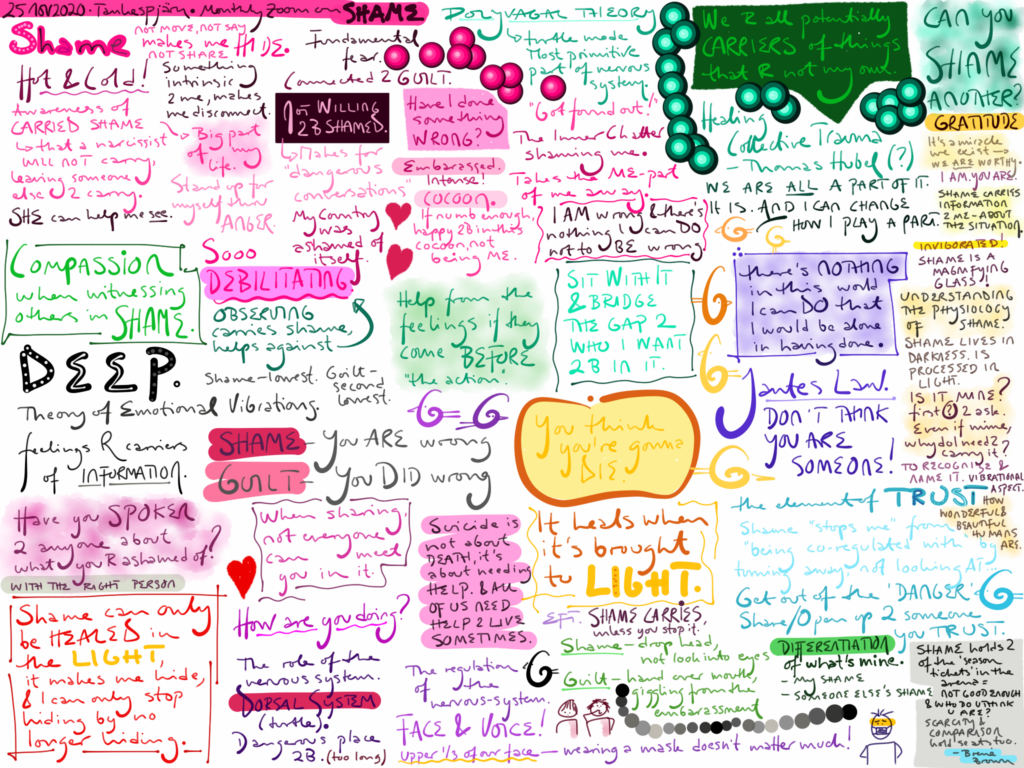The monthly tankespjärn-community Zoom-sessions stay with me, very much top of mind, as the saying goes, and the November-session on shame is no exception.
The sensation of shame in the body – the way it can feel both hot and cold, all at once, how it makes me hide, freeze, become almost paralyzed, in words as well as movement. Have I done something wrong? Am I wrong? I AM wrong, and there’s nothing I can do to NOT be wrong. The connection to guilt is obvious, and regardless of what the shame is about, it can be so utterly debilitating. Shame can wrap me inside a cocoon, and, paradoxically, if I numb myself enough, that can even become a place of happiness… if I have numbed myself enough!
It’s a heavy topic, and yet… witnessing nine souls brave it, fills me with compassion and hope. My eyes were opened to the concept of carried shame, which, I’ve discovered in the days since the call, is not just valid for shame. There’s so much I can carry that’s not mine… we are all potential carriers of things that do not belong to us, and this… helps. Weirdly enough.
Have you seen the meme of a person stopping a bus from running over a child?
This is what I imagine when I look at my –and your– potential to stop carried shame (and other sentiments) from being passed down. I carry ”stuff” that comes from previous generations, in the same way they carry ”stuff” from the generations that preceded them, and so on. The cycle only breaks, if someone actually deals with what has been carried over from the past. Otherwise it will continue to build and build and build…
It’s strangely emboldening to think that it is within my capability to stop this. I can put a stop to some, if not all, of what I’ve had to carry, making sure it is not carried forward anymore. (No. I don’t think I can, ever, get to the all of it, but I do believe that whatever I can address, will be an act of service for those who come after me. But also, equally as important, also for those who have gone before me. So I try. I do my best. And then, when I stumble, when I fall, when I stagger at the sheer weight of it all, I am reminded that every little bit counts.)
Shame lives in darkness. And heals when brought to light.
Shame is processed, and heals, when brought to light; when it is witnessed.
This is why I believe my deep-dive into shame has been so revelatory, I am doing the work, and I am sharing it.
The hiding aspect of shame is what keeps shame alive, vibrant, continuing. When unhidden, when brought into light, when no longer kept under wraps, it cannot not transform. The only way to stop the hiding is to stop the hiding.
And.
At the same time, discernment in what I am sharing and with whom is most important.
Not everyone will be able to meet me in the shame I carry, in the shame I am trying, wanting, needing to shine a light on.
And.
As with everything else, there is information in shame.
When I feel shame, I am being informed. Of beliefs (mine and/or from the cultural context I am steeped in), of energies not tended to, of the situation at hand. If I approach it thus, perhaps the felt experience will not shepherd me into darkness, paralysis and hiding, but rather, give me an opportunity to bear witness to what is going on, so that I can address it, tend to it, tend to me. In this way, shame (as much as every other felt experience) acts as a magnifying glass. It is virtually impossible to not pick up on signals of shame, they are so effective in their communication that I, at least, find it very hard to ignore.
And when I don’t, I have a chance to ask Is it mine? And even if the answer is yes, what of it? What is the message? What is the information carried forth through the sensation of shame?
